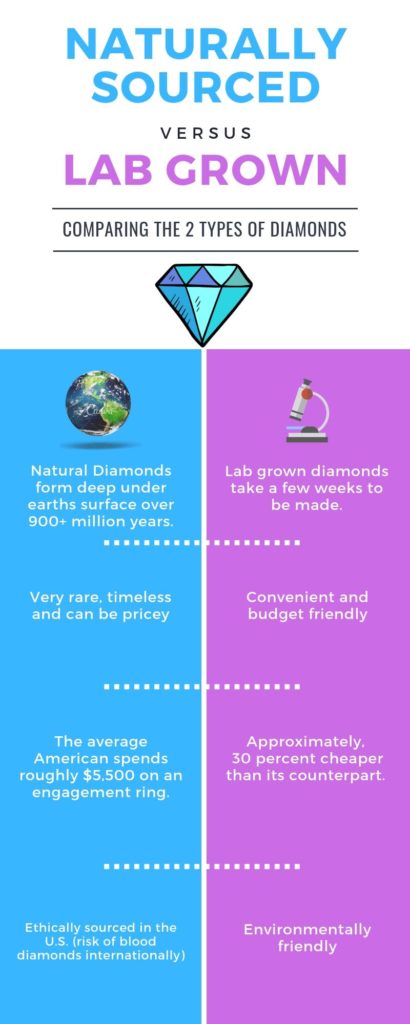Not known Details About Lab Grown Diamonds
Table of ContentsThe smart Trick of Lab Grown Diamonds That Nobody is DiscussingThe Definitive Guide for Lab Grown DiamondsThe Buzz on Lab Grown DiamondsThe Basic Principles Of Lab Grown Diamonds
As you travel closer to the Planet's core, stress and temperature rise, which develops the ideal oven for carbon to be converted into diamond (diamonds are the only gemstone to be made from simply one element). Via a substantial volcanic eruption, these rubies were transferred to the Earth's surface area. It's estimated this process was fairly fast (probably throughout numerous hours), which enabled the diamonds to remain undamaged without melting.The short answer: carats measure the mass of stones, karats measure the purity of gold. Carat weight: 1 carat weight is equal to 0.2 grams, about the weight of a paperclip (next time you see a picture of Mariah Carey's 35 carat interaction ring, simply think of the problem of lugging 35 paper clips around your finger daily).

Here are some of the crucial benefits of lab grown diamonds and lab produced diamond jewellery:.
The Ultimate Guide To Lab Grown Diamonds
Put just, natural or earth-mined rubies are crafted over numerous years under the Earth's crust from pure carbon integrated with pressure and heat. Developing rubies in a laboratory requires the same procedure, simply fine-tuned to occur over a much smaller sized time framework in a far more regulated setup.
Whereas earth-mined rubies are uncommon and finite and tend to increase in price over time, lab rubies are conveniently offered., like lab-grown ruby rings, they will not be a good fit for your needs.
They could assume that the disadvantages of lab-grown rubies outweigh the pros. Problems, battles, and human rights concerns are all come together with the diamond industry. That claimed, the diamond market does offer income to third-world nations. Some might argue that, therefore, buying a lab-made diamond additionally features its ethical factors to consider, as doing so takes income far from those associated with the natural ruby sector that may require it most.
Typical diamonds rely on the Planet's problems to determine their high quality or lack thereof. In a lab, suppliers can directly manage a diamond's quality.
Some Ideas on Lab Grown Diamonds You Should Know
You can easily discover tinted, man-made rubies on the (fairly) economical side as well as particular cuts that would be pricier if you were going shopping for a mined diamond only. That hardly suggests it isn't worth protecting.
natural diamonds is that the last is mined from all-natural down payments in the Earth while the previous is made in a lab utilizing regulated settings. However their high quality is largely the exact same. Lab Grown Diamonds. While the distinction in between lab-grown and natural ruby options are marginal when it pertains to quality, several of the disadvantages of lab-grown diamonds include the fact that the rock will certainly depreciate over time and, see this to some, an absence of nostalgic value that's usually connected with mined rubies
The process includes minimal land disruption and removes problems connected to logging and habitat destruction. Lab-grown diamonds are commonly extra cost effective than all-natural diamonds. This expense distinction can be credited to the streamlined manufacturing process and the avoidance of expenses related to conventional mining. The Controlled Atmosphere in Which Laboratory Grown Diamonds Are Created Allows for Consistent High Quality.
Flexibility in Design - Laboratory Grown Diamonds Deal Developers and Customers a Versatile Palette to Create One-of-a-kind and Cutting-edge Precious Jewelry Styles - Lab Grown Diamonds. Lab Rubies Commonly Come with An Even More Clear Supply Chain.
6 Easy Facts About Lab Grown Diamonds Shown
Market Understanding - Regardless Of Their The Same Physical Properties, Lab Diamonds May Face Challenges in Market Perception. Some Customers Still Perceive Natural Diamonds as Having Greater Value and Prestige. The Production of Lab-Grown Diamonds Can Be Energy-Intensive, Particularly in Methods Like High Pressure Heat (hpht) and Chemical Vapor Deposition (cvd).
Natural Diamonds Are Created Over Numerous Years Deep Within the Planet, Contributing to Their Perceived Rarity. Lab-Grown Rubies, In Spite Of Their The Same Residence, May Not Carry the Exact Same Rarity Aspect, Impacting Their Perceived Worth for Some Customers. Effect On Diamond-Dependent Economic Situations - the Shift In The Direction Of Laboratory Grown Diamonds May Have Financial Implications for Nations and Neighborhoods that Depend on The Ruby Mining Industry.

Ans. Laboratory Diamonds Are of Equal High Quality to Natural Diamonds in Regards To Hardness, Luster, and Clearness. the Top quality of A Ruby, Whether Lab-Grown or Mined, Is Determined by Its Cut, Shade, Quality, and Carat Weight. Ans. Yes, Lab Diamonds Shimmer Much Like Natural Diamonds. Their Radiance and Sparkle Are an Outcome of Their Cut and The Way Light Connects with Their Facets. Ans.